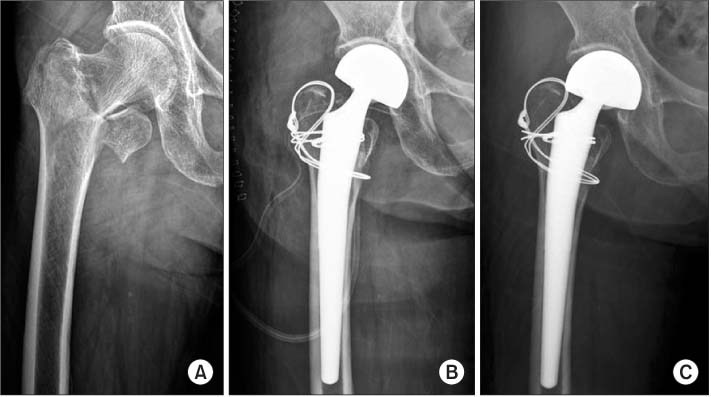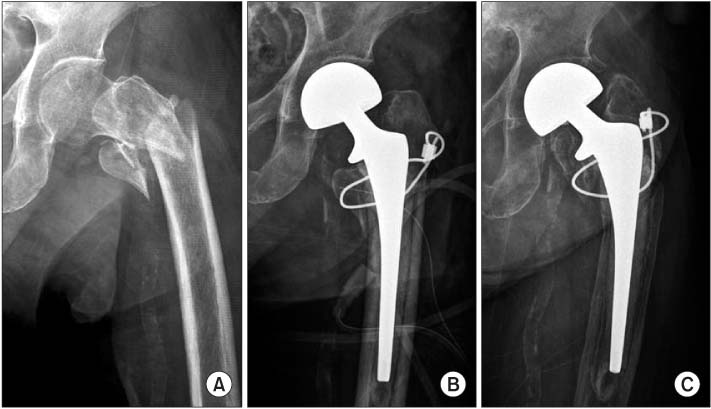J Korean Orthop Assoc.
2015 Dec;50(6):483-490. 10.4055/jkoa.2015.50.6.483.
Bipolar Hemiarthroplasty for Unstable Intertrochanteric Femur Fracture in Patients over the Age of 80 Years: Comparative Analysis between Cementless and Cemented Stem
- Affiliations
-
- 1Department of Orthopaedic Surgery, Kosin University Gospel Hospital, Busan, Korea. shchung@kosin.ac.kr
- KMID: 2185089
- DOI: http://doi.org/10.4055/jkoa.2015.50.6.483
Abstract
- PURPOSE
The purpose of this study was to evaluate the effectiveness of bipolar hemiarthroplasty for unstable intertrochanteric fracture in patients over the age of 80 years.
MATERIALS AND METHODS
Sixty-two patients (62 cases) who had unstable comminuted intertrochanteric fractures between January 2007 and February 2012 were evaluated. All patients were over 80 years old at the time of the diagnosis, and were followed-up for at least 12 months. Patients were divided into two groups: those who received cementless stems (group 1, n=32) and those who received cemented stems (group 2, n=30). Functional results including Harris hip score, thigh pain, Koval's ambulatory classification, postoperative mortality rate, operation time, and the amount of blood loss were evaluated.
RESULTS
The operation time and the amount of blood loss were significantly lower in group 1 compared to group 2. The Harris hip score was 82.1+/-8.6 points for group 1 and 83.4+/-7.5 points for group 2 at the final follow-up. One patient with poor cement press-fit level in group 2 experienced thigh pain. Twenty-seven patients (84.4%) in group 1 and 25 patients (83.3%) in group 2 recovered pre-injury ambulatory status. During the follow-up period, overall, 6 patients (18.8%) in group 1 and 8 patients (26.7%) in group 2 died. No significant differences in follow-up mortality rates were observed between the two groups.
CONCLUSION
Considering the satisfactory clinical results, cementless bipolar hemiarthroplasty may be a good treatment option for patients over 80 years old with unstable intertrochanteric fracture.
Keyword
MeSH Terms
Figure
Reference
-
1. Choy WS, Ahn JH, Ko JH, Kam BS, Lee DH. Cementless bipolar hemiarthroplasty for unstable intertrochanteric fractures in elderly patients. Clin Orthop Surg. 2010; 2:221–226.
Article2. Baumgaertner MR, Chrostowski JH, Levy RN. Intertrochanteric hip fractures. In : Browner BD, Levine AM, Jupiter JB, Trafton PG, editors. Skeletal trauma. Vol. 2. Philadelphia: WB Saunders;1992. p. 1833–1881.3. Bickel WH, Jackson AE. Intertrochanteric fractures of the femur; an analysis of the end results of 126 fractures treated by various methods. Surg Gynecol Obstet. 1950; 91:14–24.4. Cobelli NJ, Sadler AH. Ender rod versus compression screw fixation of hip fractures. Clin Orthop Relat Res. 1985; 201:123–129.
Article5. Kim Y, Moon JK, Hwang KT, Choi IY, Kim YH. Cementless bipolar hemiarthroplasty for unstable intertrochanteric fractures in octogenarians. Acta Orthop Traumatol Turc. 2014; 48:424–430.
Article6. Brander VA, Malhotra S, Jet J, Heinemann AW, Stulberg SD. Outcome of hip and knee arthroplasty in persons aged 80 years and older. Clin Orthop Relat Res. 1997; 345:67–78.
Article7. Ahnfelt L, Herberts P, Malchau H, Andersson GB. Prognosis of total hip replacement. A Swedish multicenter study of 4,664 revisions. Acta Orthop Scand Suppl. 1990; 238:1–26.8. Callaghan JJ, Salvati EA, Pellicci PM, Wilson PD Jr, Ranawat CS. Results of revision for mechanical failure after cemented total hip replacement, 1979 to 1982. A two to five-year follow-up. J Bone Joint Surg Am. 1985; 67:1074–1085.
Article9. Parker MJ. The management of intracapsular fractures of the proximal femur. J Bone Joint Surg Br. 2000; 82:937–941.
Article10. Parvizi J, Holiday AD, Ereth MH, Lewallen DG. The Frank Stinchfield Award. Sudden death during primary hip arthroplasty. Clin Orthop Relat Res. 1999; 369:39–48.11. Hungerford DS, Jones LC. The rationale for cementless total hip replacement. Orthop Clin North Am. 1993; 24:617–626.
Article12. Lim CH, Chung YY, Kim JS, Kim CY. Hemiarthroplasty for hip fractures in elderly patients over 80 years old: comparative analysis between femoral neck fracture and intertrochanteric fracture. Hip Pelvis. 2013; 25:44–50.13. Koval KJ, Aharonoff GB, Rosenberg AD, Bernstein RL, Zuckerman JD. Functional outcome after hip fracture. Effect of general versus regional anesthesia. Clin Orthop Relat Res. 1998; 348:37–41.14. Engh CA, Massin P, Suthers KE. Roentgenographic assessment of the biologic fixation of porous-surfaced femoral components. Clin Orthop Relat Res. 1990; 257:107–128.
Article15. Gruen TA, McNeice GM, Amstutz HC. "Modes of failure" of cemented stem-type femoral components: a radiographic analysis of loosening. Clin Orthop Relat Res. 1979; 141:17–27.16. Kelly AJ, Lee MB, Wong NS, Smith EJ, Learmonth ID. Poor reproducibility in radiographic grading of femoral cementing technique in total hip arthroplasty. J Arthroplasty. 1996; 11:525–528.
Article17. Zuckerman JD. Hip fracture. N Engl J Med. 1996; 334:1519–1525.
Article18. Kang SY, Lee EW, Kang KS, et al. Mode of fixation failures of dynamic hip screw with tsp in the treatment of unstable proximal femur fracture: biomechanical analysis and a report of 3 cases. J Korean Orthop Assoc. 2006; 41:176–180.
Article19. Stern MB, Angerman A. Comminuted intertrochanteric fractures treated with a Leinbach prosthesis. Clin Orthop Relat Res. 1987; 218:75–80.
Article20. Haentjens P, Casteleyn PP, Opdecam P. Primary bipolar arthroplasty or total hip arthroplasty for the treatment of unstable intertrochanteric and subtrochanteric fractures in elderly patients. Acta Orthop Belg. 1994; 60:Suppl 1. 124–128.21. Ereth MH, Weber JG, Abel MD, et al. Cemented versus noncemented total hip arthroplasty: embolism, hemodynamics, and intrapulmonary shunting. Mayo Clin Proc. 1992; 67:1066–1074.22. Charnley J. Long-term results of low-friction arthroplasty. Hip. 1982; 42–49.23. Kawamura H, Dunbar MJ, Murray P, Bourne RB, Rorabeck CH. The porous coated anatomic total hip replacement A ten to fourteen-year follow-up study of a cementless total hip arthroplasty. J Bone Joint Surg Am. 2001; 83:1333–1338.24. Archibeck MJ, Berger RA, Jacobs JJ, et al. Second-generation cementless total hip arthroplasty Eight to eleven-year results. J Bone Joint Surg Am. 2001; 83:1666–1673.25. Taylor F, Wright M, Zhu M. Hemiarthroplasty of the hip with and without cement: a randomized clinical trial. J Bone Joint Surg Am. 2012; 94:577–583.
Article26. Jones JB. Screw fixation of the lesser trochanteric fragment. Clin Orthop Relat Res. 1977; 123:107.
Article27. Campbell AC, Rorabeck CH, Bourne RB, Chess D, Nott L. Thigh pain after cementless hip arthroplasty. Annoyance or ill omen. J Bone Joint Surg Br. 1992; 74:63–66.
Article28. Hossain M, Andrew JG. Is there a difference in perioperative mortality between cemented and uncemented implants in hip fracture surgery? Injury. 2012; 43:2161–2164.
Article29. Kho D, Nam K, Oh S, Kim H. The analysis of postoperative mortality after bipolar hemiarthroplasty for hip fractures in the elderly. Hip Pelvis. 2013; 25:267–273.
Article
- Full Text Links
- Actions
-
Cited
- CITED
-
- Close
- Share
- Similar articles
-
- Bipolar Hemiarthroplasty with Cementless Femoral Stem for Unstable Intertrochanteric Fractures
- Comparison between Cementless and Cemented Bipolar Hemiarthroplasty for Treatment of Unstable Intertrochanteric Fractures: Systematic Review and Meta-analysis
- Comparative Study of Bipolar Hemiarthroplasty for Femur Neck Fractures Treated with Cemented versus Cementless Stem
- Fixation of Trochanteric Fragments in Cementless Bipolar Hemiarthroplasty of Unstable Intertrochanteric Fracture: Cerclage Wiring
- Cementless Bipolar Hemiarthroplasty for Unstable Intertrochanteric Fractures in Elderly Patients



